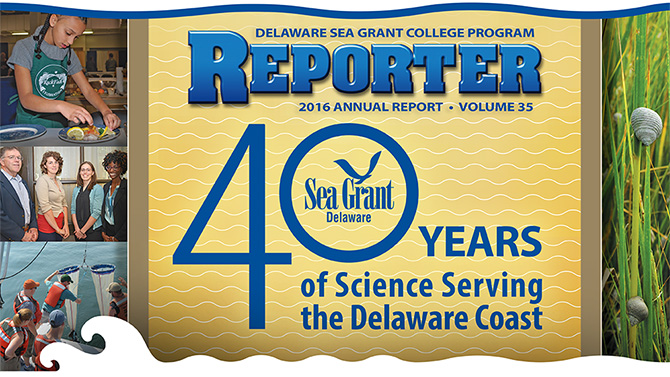


SEA GRANT UPDATE
June 15, 2016
Annual report highlights Delaware Sea Grant’s 40th anniversary
In 1966, President Lyndon Johnson signed the National Sea Grant College and Program Act into law, establishing the Sea Grant program and signaling an era of increased interest in the ocean as an important national priority. Now, 50 years later, 33 Sea Grant programs across the U.S. “put science to work” for America’s coastal communities, through federal, state, and university partnerships.
In honor of its 40th anniversary, Delaware Sea Grant’s (DESG) 2016 annual report — Reporter — celebrates its legacy of science serving the Delaware coast while contributing real solutions and tools to address emerging environmental challenges in coastal and marine environments.
In 1968, the first Sea Grant project award was made to the University of Delaware, to focus on the revitalization of the dwindling oyster industry. Eight years later, in 1976, UD was named the ninth Sea Grant college in the nation and the administration of DESG was assigned to UD’s Graduate College of Marine Studies, which is now the College of Earth, Ocean, and Environment. View a timeline of historic DESG events, on the program’s website.
With funding from the National Oceanic and Atmospheric Administration (NOAA), the state of Delaware and the University of Delaware, DESG’s work has provided communities with the science-based knowledge and resources needed to support healthy coastal ecosystems; resilient communities and economies; sustainable fisheries and aquaculture; and environmental literacy and workforce development.
While the cumulative impact of DESG’s 40 years of work is difficult to quantify, some of DESG’s most notable projects are:
- DESG informed U.S. wind energy efforts through research, policy and scientific study at the 2.2 megawatt wind turbine located on UD’s Lewes campus.
- DESG helped develop the national rip current awareness campaign called “Break the Grip of the Rip.” Today, consistent signage is posted at beaches across the nation to make beachgoers more aware of rip current dangers, and is one of many targeted outreach activities.
- Research and development supported by DESG has resulted in a freely available, practical alternative recipe for eel and conch bait, helping to preserve Delaware’s horseshoe crab population.
Equally impressive are current Delaware Sea Grant-funded research projects aimed at understanding surf zone injuries at the beach; monitoring of coastal health and resilience along the Delaware coast; and surveying zooplankton distribution abundance to inform fisheries managers, among other projects.
Published annually, Reporter encourages readers to become informed, get involved and stay connected through various Sea Grant programs. Reporter readers who complete the readership survey by Dec. 31 are entered in a drawing for Delaware Sea Grant’s coast-inspired prize package.
Contact Us
Have a UDaily story idea?
Contact us at ocm@udel.edu
Members of the press
Contact us at 302-831-NEWS or visit the Media Relations website

